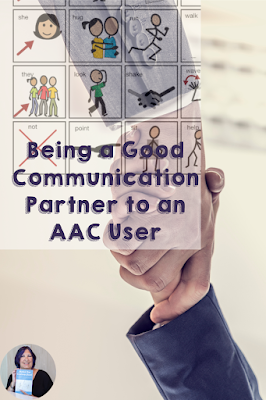I’ve written multiple times about being a good partner to an AAC user, but it always bears repeating again. It’s not always easy to know what to do, especially if you’re new to speaking with someone who is using a different mode of communication than you. And some of us are just naturally more comfortable than others when speaking with someone who is using a different kind of communication; one that is unusual or unfamiliar. Added to the struggle is that every person who uses AAC is different - just as every individual is different, of course. Some prefer that the partner not interrupt or predict what they are going to say, while others are relieved when the partner predicts their message and they don’t need to construct the rest and get a motoric - and maybe cognitive - break.
1. Create a positive communication environment
What exactly does that mean? It means we respond to all communication attempts. We provide as much support as needed, and we look for solutions to communication challenges or frustrations. Even when responding to a child’s “undesirable” behavior, you do so while modeling the more appropriate communication response in the AAC system to take advantage of the communication opportunity.
It also means creating as many opportunities for communication s possible. That means asking open-ended questions; rather than yes/no questions or other close-ended questions. Provide choices as often as possible. Sabotage the environment as possible to create opportunities - when you can do so without creating frustration.
2. Respond to all of the AAC user’s communication attempts
This is particularly crucial for a new AAC user. Not all children communicate symbolically at first. Some of their communication may be through behaviors we label as undesirable.
What the child does to communicate when he is interrupted or doesn’t get what he wants or when he needs help or when he wants someone or some activity or something or when something is wrong - all of these tell you about how he communicates specific communication functions: commenting, protesting, rejecting, requesting assistance, etc. These are some of the earliest communication functions and are mainly about regulating another’s actions.
The partner’s job is to respond to those behaviors by shaping them into more acceptable or understandable forms. And the more you use the AAC system to model how to do this, in real, genuine contexts, the more you use the AAC system, the more the child will learn to use it too.
3. Use the AAC system when speaking to the AAC user
We call this Aided Input; also known as Partner Aided Input or Aided Language Stimulation, or sometimes just called Modeling. There are some subtle differences, but I’m going to ignore those for my purposes here. Because the point is that the more we show the child how to use the system for language output, the more they understand how to do so. Language is learned through models. It is how verbal children learn to speak.
Children learning to use a picture-based communication system is learning an entirely different mode of communication. Of course, they need to see models of that mode being used for communicating.
Some other tips for partners when communicating with an AAC user?
4. Try to manage visual and auditory distractions before trying to communicate with the child
5. Make sure you have the child’s attention before starting to interact
6. Use genuine communication; talk - don’t test
7. Don’t keep talking while the child is trying to compose a message on the AAC system
8. If he says something and you understand, don’t make him use AAC to repeat it
9. If he can’t find a word in the AAC system, help him with simple prompting strategies like using categories or describing words
10. If he looks like he’s not understanding, keep it short and sweet and use AAC or other visuals to help.
You can read some of my original posts on the topic here:




No comments
Post a Comment